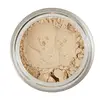What's inside
What's inside
 Key Ingredients
Key Ingredients

 Benefits
Benefits

 Concerns
Concerns

 Ingredients Side-by-side
Ingredients Side-by-side

Zinc Oxide
Cosmetic ColorantCI 77891
Cosmetic ColorantMica
Cosmetic ColorantMethicone
EmollientSodium Hyaluronate
HumectantSilica
AbrasiveAllantoin
Skin ConditioningCaprylic/Capric Triglyceride
MaskingCamellia Sinensis Leaf Extract
AntimicrobialOlea Europaea Leaf Extract
PerfumingGlycyrrhiza Glabra Root Extract
BleachingBelamcanda Chinensis Root Extract
Skin ConditioningSambucus Nigra Fruit Extract
AstringentTotarol
AntioxidantIron Oxides
CI 77491
Cosmetic ColorantCI 77492
Cosmetic ColorantCI 77499
Cosmetic ColorantDimethicone/Vinyl Dimethicone Crosspolymer
Skin ConditioningChromium Oxide Greens
CI 77288
Cosmetic ColorantUltramarines
CI 77007
Cosmetic ColorantZinc Oxide, CI 77891, Mica, Methicone, Sodium Hyaluronate, Silica, Allantoin, Caprylic/Capric Triglyceride, Camellia Sinensis Leaf Extract, Olea Europaea Leaf Extract, Glycyrrhiza Glabra Root Extract, Belamcanda Chinensis Root Extract, Sambucus Nigra Fruit Extract, Totarol, Iron Oxides, CI 77491, CI 77492, CI 77499, Dimethicone/Vinyl Dimethicone Crosspolymer, Chromium Oxide Greens, CI 77288, Ultramarines, CI 77007
Caprylic/Capric Triglyceride
MaskingPolyethylene
AbrasivePolyglyceryl-2 Triisostearate
EmulsifyingSilica
AbrasiveCera Microcristallina
Emulsion StabilisingSynthetic Fluorphlogopite
Helianthus Annuus Seed Oil
EmollientAluminum Hydroxide
EmollientTocopherol
AntioxidantCI 16035
Cosmetic ColorantCI 77007
Cosmetic ColorantCI 77491
Cosmetic ColorantCI 77492
Cosmetic ColorantCI 77499
Cosmetic ColorantCI 77742
Cosmetic ColorantCI 77891
Cosmetic ColorantCI 42090
Cosmetic Colorant
 Reviews
Reviews

Ingredients Explained
These ingredients are found in both products.
Ingredients higher up in an ingredient list are typically present in a larger amount.
This ingredient is an emollient, solvent, and texture enhancer. It is considered a skin-softener by helping the skin prevent moisture loss.
It helps thicken a product's formula and makes it easier to spread by dissolving clumping compounds.
Caprylic Triglyceride is made by combining glycerin with coconut oil, forming a clear liquid.
While there is an assumption Caprylic Triglyceride can clog pores due to it being derived from coconut oil, there is no research supporting this.
Learn more about Caprylic/Capric TriglycerideThis pigment is called Ultramarine blue lazurite. It gives a saturated blue color, but can be used to create other colors as well.
According to the manufacturer, it is usually made from kaolin, sodium sulfate, sodium carbonate, sulfur, and charcoal.
Ci 77491 is also hydrated iron III oxide. It's sole purpose is to give a red/pink hue to products.
Iron III oxides are classified as inorganic chemicals for coloring.
Synthetically created Ci 77491 is considered safer than those naturally found. This is because the synthetically created version may contain less impurities. Iron oxides are generally non-toxic and non-allergenic.
Learn more about CI 77491Ci 77492 is also hydrated iron III oxide. It's sole purpose is to give a yellow hue to products.
Iron III oxides are classified as inorganic chemicals for coloring.
Synthetically created Ci 77492 is considered safer than those naturally found. This is because the synthetically created version may contain less impurities. Iron oxides are generally non-toxic and non-allergenic.
Learn more about CI 77492Ci 77499 is also hydrated iron III oxide. It is created from mixing red and black iron oxides. This helps give shades of darkness to a product.
Iron III oxides are classified as inorganic chemicals for coloring.
Ci 77891 is a white pigment from Titanium dioxide. It is naturally found in minerals such as rutile and ilmenite.
It's main function is to add a white color to cosmetics. It can also be mixed with other colors to create different shades.
Ci 77891 is commonly found in sunscreens due to its ability to block UV rays.
Learn more about CI 77891Silica, also known as silicon dioxide, is a naturally occurring mineral. It is used as a fine, spherical, and porous powder in cosmetics.
Though it has exfoliant properties, the function of silica varies depending on the product.
The unique structure of silica enhances the spreadability and adds smoothness, making it a great texture enhancer.
It is also used as an active carrier, emulsifier, and mattifier due to its ability to absorb excess oil.
In some products, tiny microneedles called spicules are made from silica or hydrolyzed sponge. When you rub them in, they lightly polish away dead skin layers and enhance the penetration of active ingredients.
Learn more about Silica